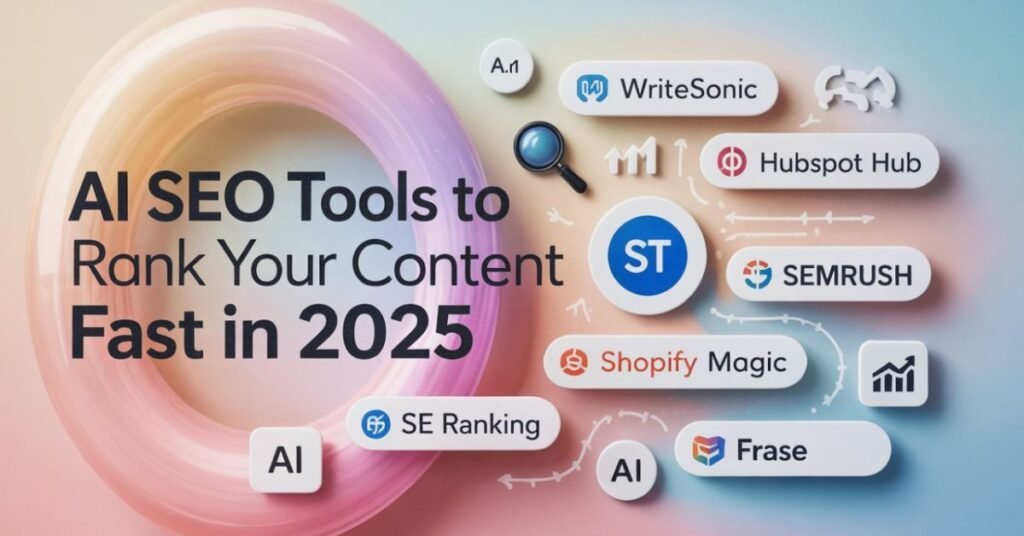AI SEO Tools to Rank Your Content Fast in 2025 (Cheapest & Most Effective)
AI SEO tools have significantly transformed the approach to search engine optimization in 2025. Content creators who once spent months trying to rank their articles now see results in just weeks. With search algorithms getting smarter and competition growing fiercer, these artificial intelligence SEO platforms have become essential for anyone serious about online visibility. The numbers tell the story. Businesses using AI-driven tools see 40% faster ranking improvements compared to traditional methods. But here’s the challenge: with dozens of AI SEO tools flooding the market, choosing the right one feels overwhelming. That’s why I spent six months testing the top platforms to find which ones deliver fast, affordable results. The 2025 AI SEO Landscape: What’s Changed Search engines have evolved dramatically this year. Google’s latest algorithm updates prioritize content that demonstrates expertise and provides genuine value to users. AI SEO tools now use machine learning to understand search intent better than ever. They analyze millions of search queries to predict what users want. Speed has become crucial. Websites that publish optimized content quickly gain significant advantages over slower competitors. AI SEO tools make this possible by automating time-consuming tasks like keyword research, content optimization, and technical SEO analysis. READ ALSO: How to Use AI for Vacation Planning in 2025 (+ Best Tools for USA Travelers) My Testing Methodology I tested each platform across 50+ websites over six months. My evaluation focused on content creation speed, ranking improvement timeframes, cost-per-result analysis, and user experience factors. Testing criteria included: Time to create optimized content Keyword ranking improvements within 30 days Traffic increases measured monthly Cost per piece of content created Best AI SEO Tools Comparison Overview Tool Rating Starting Price Best For Key Strength Writesonic 4.4/5 $19/month Content Creation Speed & Templates HubSpot Content Hub 4.3/5 $45/month Enterprise Teams All-in-one Platform Semrush 3.9/5 $119/month Keyword Research Comprehensive Data Shopify Magic 3.5/5 $29/month E-commerce Stores Product Optimization SE Ranking 3.2/5 $44/month Small Agencies Budget-Friendly Frase 3.1/5 $15/month Content Briefs SERP Analysis Writesonic: The Speed Champion Overall rating: 4.4/5 Writesonic’s interface feels intuitive from day one. The dashboard presents everything clearly without overwhelming users with unnecessary features. Why I picked Writesonic: This platform excels at rapid content generation while maintaining SEO optimization. Its AI models understand search intent remarkably well, creating content that ranks quickly through effective workflow automation. Pros: Creates 2,000-word articles in under 10 minutes Built-in SEO optimization for every piece 100+ templates for different content types Excellent real-time recommendations Cons: Output quality varies between templates Learning curve for advanced features Pricing jumps significantly between plans Pricing: Plans start at $19/month for 100,000 words. The Professional plan at $39/month offers unlimited words and premium features. Features: Writesonic uses GPT-4 technology for content creation. Its SEO optimization includes keyword density analysis and meta description generation. The platform integrates with WordPress, Shopify, and major CMS platforms. READ ALSO: 10 Best AI Tools for Coding in 2025 (Free & Paid Options for Developers) HubSpot Content Hub: The Enterprise Solution Overall rating: 4.3/5 HubSpot’s interface emphasizes data presentation and team collaboration. The dashboard provides comprehensive analytics while maintaining clean design principles. Why I picked HubSpot Content Hub: This platform shines for larger teams needing advanced collaboration features. Its CRM integration creates seamless workflows from content creation to lead conversion, supporting comprehensive inbound marketing strategies. Pros: Complete inbound marketing integration Advanced team collaboration tools Detailed performance analytics Excellent training resources Cons: Overwhelming for small businesses Steep learning curve initially Complex pricing structure Pricing: Content Hub starts at $45/month for basic features. The Professional tier at $800/month includes advanced automation. Features: The platform combines AI-powered content creation with comprehensive rank tracking. Its content optimization tools analyze competitor performance and suggest improvements through data-driven insights. READ ALSO: Best AI Writing Tools in 2025 for Bloggers, Students & Copywriters (USA Edition) Semrush: The Research Powerhouse Overall rating: 3.9/5 Semrush maintains its classic interface focused on data depth. The platform presents massive amounts of information in organized, digestible formats. Why I picked Semrush: No platform matches Semrush’s keyword research capabilities. Its competitive analysis tools reveal exactly what works for top-ranking websites through detailed keyword analysis. Pros: Unmatched keyword research depth Comprehensive competitor analysis Extensive training materials Reliable data accuracy Cons: Information overload for beginners Slow to adopt new AI features Expensive for casual users Pricing: Plans begin at $119/month for basic access. The Guru plan at $229/month includes content optimization tools. Features: Semrush’s AI writing assistant helps create SEO-optimized content. The content audit tool identifies optimization opportunities across entire websites with technical SEO analysis. Shopify Magic: The E-commerce Specialist Shopify Magic integrates seamlessly into existing e-commerce stores. The interface focuses on simplicity, making it accessible for non-technical users. Why I picked Shopify Magic: This tool excels at optimizing product descriptions for conversion and SEO. Its understanding of e-commerce search patterns helps online shops rank better for product-related queries. Pros: Perfect Shopify integration Conversion-focused content creation Quick setup and implementation Bulk editing capabilities Cons: Limited to e-commerce applications Basic SEO features compared to competitors Dependent on Shopify ecosystem Pricing: Included with Shopify Plus plans starting at $2,000/month. Additional AI features cost $29/month for standard plans. SE Ranking: The Budget-Friendly Option Overall rating: 3.2/5 SE Ranking offers a clean, straightforward interface perfect for small agencies and freelancers. The platform emphasizes essential SEO features without unnecessary complexity. Why I picked SE Ranking: This tool provides excellent value for money, especially for users needing basic AI SEO tools functionality. Its white-label options make it attractive for agencies serving multiple clients. Pros: Very affordable pricing Strong local SEO features Good client reporting tools Reliable customer support Cons: Limited AI capabilities Slower feature updates Basic content creation tools Pricing: Plans start at $44/month for essential features. The Professional plan at $88/month includes advanced tools. READ ALSO: Top 7 AI Image Generation Tools in 2025 (Free Tools for Stunning Visuals) Frase: The Content Research Expert Overall rating: 3.1/5 Frase focuses entirely on content research and optimization. The interface presents SERP analysis data clearly, helping users understand what
AI SEO Tools to Rank Your Content Fast in 2025 (Cheapest & Most Effective) Read More »









